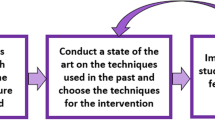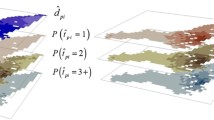Abstract
Informational interventions are important to bring positive changes in attitudes and perception among individuals. In relation to the individual’s mobility behavior, habits, attitudes, and perceptions are difficult to change. Therefore, it is vital to identify relatively soft aspects of travel behavior with a potential to reduce the negative impacts of mobility on the environment and individual health. This paper provides a methodological framework and describes the development of a computational algorithm that helps to identify soft changes in the travel behavior. The algorithm is based on a variety of different data sources such as activity-travel diaries and related constraint information, meteorological conditions, bicycle and public transport supply data, and emissions and air pollutant concentrations data. A variety of rules that are part of the algorithm are derived from the transport modeling literature, where constraints and factors were examined for activity-travel decisions. Three major aspects of activity-travel behavior, such as reduced car use, cold start of car engines, and participation in non-mandatory outdoor activities are considered in assessing pro-environmental potential. The algorithm is applied to collected small datasets from citizens of Hasselt (Belgium), Bologna (Italy), and Guildford (UK). A significant replaceable potential for car trips within 3 km to cycling and car trips to public transport has been found. The replaceable potential of excessive cold starts and participation in non-mandatory outdoor activities were also found, to some extent, to bring positive changes in the environment. In future research, these identified potentials are reported back to individuals with their consequence as part of a mobility-based informational intervention.








Similar content being viewed by others
References
EEA (2016) Air quality in Europe — 2016 report, report no. 28/2016. European Environmental Agency. Publications Office of the European Union, Luxembourg. https://doi.org/10.2800/413142
Steg L, Vlek C (2009) Encouraging pro-environmental behavior: an integrative review and research agenda. J Environ Psychol 29(3):309–317. https://doi.org/10.1016/j.jenvp.2008.10.004
Osbaldiston R, Schott JP (2012) Environmental sustainability and behavioral science: meta-analysis of proenvironmental behavior experiments. Environ Behav 44(2):257–299
Schultz PW (2014) Strategies for promoting proenvironmental behavior. Eur Psychol 19(2):107–117. https://doi.org/10.1027/1016-9040/a000163
Eriksson L, Forward SE (2011) Is the intention to travel in a pro-environmental manner and the intention to use the car determined by different factors? Transp Res Part D: Transp Environ 16(5):372–376. https://doi.org/10.1016/j.trd.2011.02.003
de Nazelle A, Morton BJ, Jerrett M, Crawford-Brown D (2010) Short trips: an opportunity for reducing mobile-source emissions? Transp Res Part D: Transp Environ 15(8):451–457. https://doi.org/10.1016/j.trd.2010.04.012
Kim S, Ulfarsson GF (2008) Curbing automobile use for sustainable transportation: analysis of mode choice on short home-based trips. Transportation 35(6):723–737. https://doi.org/10.1007/s11116-008-9177-5
Schmidt K (2016) Explaining and promoting household food waste-prevention by an environmental psychological based intervention study. Resour Conserv Recycl 111:53–66. https://doi.org/10.1016/j.resconrec.2016.04.006
Lieberoth A, Holm Jensen N, Bredahl T (2018) Selective psychological effects of nudging, gamification and rational information in converting commuters from cars to buses: a controlled field experiment. Transport Res F: Traffic Psychol Behav 55:246–261. https://doi.org/10.1016/j.trf.2018.02.016
Möser G, Bamberg S (2008) The effectiveness of soft transport policy measures: a critical assessment and meta-analysis of empirical evidence. J Environ Psychol 28(1):10–26. https://doi.org/10.1016/j.jenvp.2007.09.001
Bamberg S, Fujii S, Friman M, Gärling T (2011) Behavior theory and soft transport policy measures. Transp Policy 18(1):228–235. https://doi.org/10.1016/j.tranpol.2010.08.006
Chatterjee K, Bonsall P (2009) Special issue on evaluation of programmes promoting voluntary change in travel behavior. Transp Policy 16(6):279–280. https://doi.org/10.1016/j.tranpol.2009.10.001
Mikiki F, Papaioannou P (2012) Investigating pro-environmental and active travel behavior for successful sustainable travel promotion. Procedia Soc Behav Sci 48:1424–1433. https://doi.org/10.1016/j.sbspro.2012.06.1118
Stopher PR, Bullock P (2003) Travel behavior modification: a critical appraisal. Paper presented at the 26th Australasian Transport Research Forum, Wellington, New Zealand,
Scheepers CE, Wendel-Vos GCW, den Broeder JM, van Kempen EEMM, van Wesemael PJV, Schuit AJ (2014) Shifting from car to active transport: a systematic review of the effectiveness of interventions. Transp Res A Policy Pract 70:264–280. https://doi.org/10.1016/j.tra.2014.10.015
Arroyo R, Ruiz T, Casquero D, Mars L (2018) Trip characteristics analysis of the effects of a travel behavior change program. Transp Res Rec. https://doi.org/10.1177/0361198118773184
Brog W (1998) Schadler M Marketing in public transport is an investment, not a cost. . In: 22nd Australian transport research forum, Sydney
Rose G, Ampt E (2001) Travel blending: an Australian travel awareness initiative. Transp Res Part D: Transp Environ 6:95–110
Cairns S, Sloman L, Newson C, Anable J, Kirkbride A, Goodwin P (2008) Smarter choices: assessing the potential to achieve traffic reduction using ‘soft measures’. Transp Rev 28(5):593–618. https://doi.org/10.1080/01441640801892504
Fujii S, Taniguchi A (2006) Determinants of the effectiveness of travel feedback programs—a review of communicative mobility management measures for changing travel behavior in Japan. Transp Policy 13(5):339–348. https://doi.org/10.1016/j.tranpol.2005.12.007
Zhao F, Pereira FC, Ball R, Kim Y, Han Y, Zegras C, Ben-Akiva M (2015) Exploratory analysis of a smartphone-based travel survey in Singapore. Transp Res Rec 2(2494):45–56
Beckx C, Broekx S, Degraeuwe B, Beusen B, Int Panis L (2013) Limits to active transport substitution of short car trips. Transp Res Part D: Transp Environ 22:10–13. https://doi.org/10.1016/j.trd.2013.03.001
James B, Brog W (1999) Potential for increasing public transport, cycling and walking trips. Paper presented at the 23rd Australian Transport Research Forum, Perth, Western Australia,
ALR (2016) Moving toward active transportation: how policies can encourage walking and bicycling. Active Living Research
Weiss M, Paffumi E, Clairotte M, Drossinos Y, Vlachos T, Bonnel P, Giechaskiel B (2017) Including cold-start emissions in the real-driving emissions (RDE) test procedure: an assessment of cold-start frequencies and emission effects. Joint Research Center Science for Policy Report. JRC Science Hub, Luxembourg: publications Office of the European Union. doi:doi:https://doi.org/10.2760/70237
Bielaczyc P, Merkisz J, Pielecha J (2001) Investigation of exhaust emissions from DI diesel engine during cold and warm start. Paper presented at the SAE 2001 World Congress, Detroit, Michigan, March 5-8, 2001
Schoenau M, Müller M (2017) What affects our urban travel behavior? A GPS-based evaluation of internal and external determinants of sustainable mobility in Stuttgart (Germany). Transp Res Part F: Traffic Psychol and Behav 48:61–73. https://doi.org/10.1016/j.trf.2017.05.004
Saneinejad S, Roorda MJ, Kennedy C (2012) Modelling the impact of weather conditions on active transportation travel behavior. Transp Res Part D: Transp Environ 17(2):129–137. https://doi.org/10.1016/j.trd.2011.09.005
Sugiyama T (2018) Cycling: increasing diversity in users, contexts and modalities. Journal of Transport & Health 10:3–4. https://doi.org/10.1016/j.jth.2018.08.008
Beckx C, Denys T (2016) Flemish Institute for Technological Research. In: Analysis of total Belgian car fleet 2015, Flanders
Kaur S, Nieuwenhuijsen MJ, Colvile RN (2007) Fine particulate matter and carbon monoxide exposure concentrations in urban street transport microenvironments. Atmos Environ 41(23):4781–4810. https://doi.org/10.1016/j.atmosenv.2007.02.002
Richter J, Friman M, Gärling T (2011) Soft transport policy measures: gaps in knowledge. Int J Sustain Transp 5(4):199–215
Pucher J, Dill J, Handy S (2010) Infrastructure, programs, and policies to increase bicycling: an international review. Prev Med 50:S106–S125
Cole R, Turrell G, Koohsari MJ, Owen N, Sugiyama T (2017) Prevalence and correlates of walkable short car trips: a cross-sectional multilevel analysis. J Transp Health 4:73–80. https://doi.org/10.1016/j.jth.2016.11.007
Lee J, He SY, Sohn DW (2017) Potential of converting short car trips to active trips: the role of the built environment in tour-based travel. J Transp Health 7:134–148. https://doi.org/10.1016/j.jth.2017.08.008
Gerharz LE, Krüger A, Klemm O (2009) Applying indoor and outdoor modeling techniques to estimate individual exposure to PM2. 5 from personal GPS profiles and diaries: a pilot study. Sci Total Environ 407(18):5184–5193
Zahabi SAH, Chang A, Miranda-Moreno LF, Patterson Z (2016) Exploring the link between the neighborhood typologies, bicycle infrastructure and commuting cycling over time and the potential impact on commuter GHG emissions. Transp Res Part D: Transp Environ 47:89–103. https://doi.org/10.1016/j.trd.2016.05.008
Daily Air Quality Index (2017) Department for Environment Food & Rural Affairs, UK. https://uk-air.defra.gov.uk. Accessed 5th of June 2017
Organization WH (2010) Global recommendations on physical activity for health. World Health Organization, Geneva
Barrett L, Galik G, Hristova D, Cowie P, Caro F (2017) Challenges and opportunities in the iSCAPE Cities
Graham-Rowe E, Skippon S, Gardner B, Abraham C (2011) Can we reduce car use and, if so, how? A review of available evidence. Transp Res A Policy Pract 45(5):401–418. https://doi.org/10.1016/j.tra.2011.02.001
Functional urban areas in OCED countries: Italy. (2016). www.oecd.org. Accessed 14th of June 2018
Average weather in November in Bologna. https://weatherspark.com. Accessed 7th of August 2018
Guildford Climate. https://www.metoffice.gov.uk/public/weather/climate/gcpe7p302. Accessed 7th of August 2018
Mägdefrau N, Staufenbiel J, Schmitt HC, Gollmann C, Weißer B, Hurth F, Kirstein M, Kumar P, Greiving S (2017) Report on solutions at urban level
Funding
This project has received funding from the European Union Horizon 2020 research and innovation program under grant agreement no. 689954.
Author information
Authors and Affiliations
Corresponding author
Ethics declarations
Disclaimer
This paper reflects the authors’ views. The European Commission is not liable for any use that may be made of the information contained therein.
Additional information
Publisher’s Note
Springer Nature remains neutral with regard to jurisdictional claims in published maps and institutional affiliations.
Rights and permissions
About this article
Cite this article
Ahmed, S., Adnan, M., Janssens, D. et al. Estimating pro-environmental potential for the development of mobility-based informational intervention: a data-driven algorithm. Pers Ubiquit Comput 23, 653–668 (2019). https://doi.org/10.1007/s00779-018-1187-5
Received:
Accepted:
Published:
Issue Date:
DOI: https://doi.org/10.1007/s00779-018-1187-5




